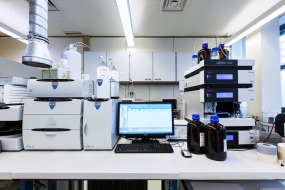Radiotracer Unit
Team Leader: Dr. rer. nat. Ute Hennrich

Quality control of radiopharmaceuticals
© S. Arndt
The Radiotracer group is currently working on the following topics:
- Establishment of GMP compliant production and quality control
The working group has a long-standing expertise in the GMP compliant production of radiopharmaceuticals for human use. For example, they possessed a marketing authorization for [18F]FDG and manufacturing authorizations for [18F]FET, [18F]FLT, and [68Ga]Ga-PSMA-11. Due to lack of necessary clean rooms, the production of complex radiopharmaceuticals for human application is not possible at the moment. But as soon as the new GMP building FER will be built and commissioned, the GMP production of radiopharmaceuticals will be taken up again.
Therefor the production and quality control of new radiotracers, like [18F]FAPI-74, for the translation into clinics is being developed and established. This includes on the one hand the development of a GMP compliant, fully automated production with suitable synthesis modules and on the other hand the development of suitable analytical methods for the quality control of the products. Following development, the respective methods have to be validated GMP compliantly [1], in order to allow their routine use in the GMP production of radiopharmaceuticals.
- Production of 68Ga-radiotracers using approved precursors
Due to lack of suitable clean rooms, the production of complex radiopharmaceuticals for human use is currently not possible. In order to provide a basic supply of the department of Nuclear Medicine with 68Ga-radiotracers for positron emission tomography (PET), the PET tracers [68Ga]Ga-PSMA-11 (prostatic cancer) [2] and [68Ga]Ga-DOTA-TOC (neuroendocrine tumors) [3] will be produced by means of sterile, authorized kits and a sterile, authorized 68Ge/68Ga-generator as soon as the necessary approvals have been granted.
- Production of new and established radiotracers for application in pre-clinical evaluations
The working group provides established as well as new radiotracers for pre-clinical evaluations. The portfolio of established tracers includes e.g. [18F]FET (imaging of amino acid transport), [18F]FLT (imaging of thymidine transport), Na[18F]F (imaging of osteoblastic activity), and [18F]PSMA-1007 (imaging of prostate specific membrane antigen). Additionally new tracers, like [68Ga]Ga-FAPI-46 (imaging of fibroblast activation protein) or [18F]FAZA (imaging of hypoxia), can be provided. Establishing further new tracers in collaboration with other internal groups is planned.
- Development and evaluation of new radiotracers for molecular targets
In the working group, new radiotracers for molecular targets, e.g. CXCR4 (chemokine receptor), are developed. These CXCR4 inhibitors are either small organic molecules or peptides which are labelled with fluorine-18 or gallium-68. The multistep organic or peptide syntheses have to be optimized in order to get the non-radioactively labelled target compounds. These precursors are then radioactively labelled with the respective radionuclide in as less steps as possible. The radioactively labelled compounds are evaluated in vitro and in vivo to determine their suitability for the imaging of CXCR4.
[1] Katzschmann, I., Marx, H., Kopka, K., Hennrich, U. Development and Validation of a GMP-Compliant High-Pressure Liquid Chromatography Method for the Determination of the Chemical and Radiochemical Purity of [18F]PSMA-1007, a PET Tracer for the Imaging of Prostate Cancer. Pharmaceuticals 14, (2021). DOI: 10.3390/ph14030188.
[2] Hennrich, U., Eder, M. [68Ga]Ga-PSMA-11: The First FDA-Approved 68Ga-Radiopharmaceutical for PET Imaging of Prostate Cancer. Pharmaceuticals 14, (2021). DOI: 10.3390/ph14080713.
[3] Hennrich, U., Benesova, M. [68Ga]Ga-DOTA-TOC: The First FDA-Approved 68Ga-Radiopharmaceutical for PET Imaging. Pharmaceuticals 13, (2020). DOI: 10.3390/ph13030038.
